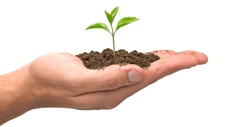Uses of Soil

TEKS Objective
The student is expected to gather evidence of how rocks, soil, and water help to make useful products.
Essential Understanding
The student knows that the natural world includes rocks, soil, and water that can be observed in cycles, patterns, and systems.
Science Background
What is Soil? US Bureau of Land Management (website) - Engaging information and activities focused on soil’s composition, importance to life on Earth, and more.
What is Soil?
US Bureau of Land Management, www.blm.gov
The Dirt on Soil: Discovery Education (website) - Dig into the underground universe of soil with this online guided tour.
The Dirt on Soil
Discovery Education, school.discoveryeducation.com
Sand and Sand Mining: University of Michigan (website) – Sand is the major component of glass, foundry molds, and abrasives. It also is used in ceramics. Find out more here.
Sand and Sand Mining
University of Michigan Department of Geography, www.geo.msu.edu
Signature Lesson
Brick by Brick: Ohio Department of Education (website) – Students create, experiment with and gather evidence about making bricks from soil.
Brick by Brick
Ohio Department of Education, ode.state.oh.us
- Supporting Lessons
- Extensions
- Assessment Ideas
- Literature Connections
- Related
TEKS - Additional Resources
Supporting Lessons
How to Make Bricks: eHow (website) - Making bricks from soil and straw is a fun project for children or adults. Learn how to make your own bricks for use at home or school.
How to Make Miniature Adobe Bricks for Kids: eHow (website) - Many buildings in the southwest US are constructed from adobe bricks made of clay, sand and water. Your class can make miniature adobe bricks following the steps described here.
How to Make Miniature Adobe Bricks for Kids
by By Kara Bietz, eHow.com
Natural Earth Materials - Rocks, Soil and Water: Baylor College of Medicine (PDF) - Students will be observe and record examples of ways earth materials are useful.
Natural Earth Materials - Rocks, Soil and Water
Baylor College of Medicine, SuperSTAAR.org
Elaboration Lessons and Extensions
We All Need Soil! The GLOBE Program (PDF) - Explore three activities that promote understanding of, and respect for soil and its uses.
We All Need Soil!
The GLOBE Program, classic.globe.gov
Properties of Rocks and Soil: University of Missouri, eThemes (website) - Learn about the properties of rocks and soil, how rocks are made, and how soil is formed.
Properties of Rocks and Soil
University of Missouri, eThemes, ethemes.missouri.edu
Assessment Ideas
Have each student create a four-page book, and start every page with: Soil may be used to ____. Then have students add pictures to enhance each page and verbally describe how soil is used by humans and other animals.
Literature Connections
The Amazing Dirt Book. Bourgeois, Paulette (ISBN: 0201550962)
A Handful of Dirt. Bial, Raymond (ISBN: 0802786987)
Our Endangered Planet: Soil. Winckler, Suzanne (ISBN: 0822525089)
Additional Resources
Soil Stories: Natural Resources Conservation Service (video) - Join Francine as she discovers that soil is an important natural resource, without which we would not exist. In her journey, she meets a soil scientist who helps her “see” beneath the surface of the soil and helps her understand what’s going on down there.
Soil Stories
Natural Resources Conservation Service, US Department of Agriculture, nrcs.usda.gov
Underground Adventure: The Field Museum (website) - There’s more to soil than meets the eye. Learn why Earth’s soil is a rich habitat for many amazing creatures, and how it can be used to make useful products.
Underground Adventure
The Field Museum, www.fieldmuseum.org
Look Out, Below: Oklahoma State Cooperative Extension Service (PDF) - Teacher background information about the four layers of soil and the substances that make up each level.
Look Out, Below
Oklahoma State Cooperative Extension Service, oklahoma4h.okstate.edu
TEKS Navigation
Grade 1
Need Assistance?
If you need help or have a question please use the links below to help resolve your problem.

Comments